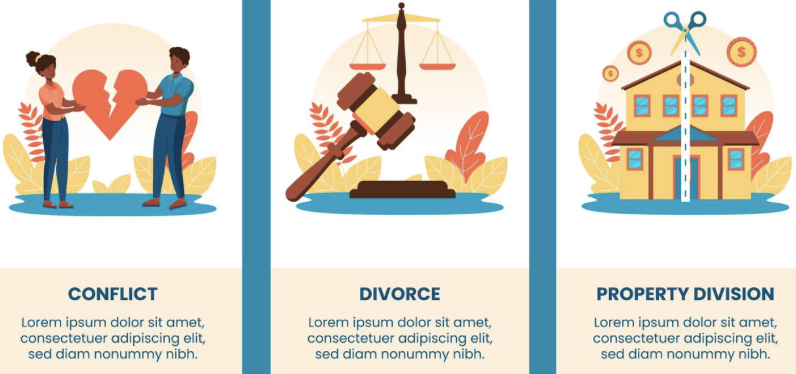In Mexico, divorce is a legal process that ends the marriage bond between two people.As of 2025, the Mexican legal system has modernized this procedure to make it faster and more accessible — even allowing online filings in several states.
This comprehensive guide explains everything you need to know about the types of divorce, your legal rights, the approximate costs, the step-by-step procedure, and the common mistakes to avoid during the process.
History and Evolution of Divorce in Mexico
Divorce was first recognized in Mexico under the 1917 Constitution, and it has evolved through reforms to the Federal Civil Code and state laws across the country.
Today, more streamlined procedures exist, such as “no-fault” divorce (or “express divorce”), first introduced in Mexico City in 2008. This reform eliminated the need to justify specific reasons before a judge — making divorce more accessible.
Supreme Court of Justice of the Nation – SCJN (Official site)
What Is Divorce in Mexico?
Divorce is the legal act that dissolves a marriage and ends the civil rights and obligations between spouses.
According to the Federal Civil Code, there are two main types of divorce: voluntary and judicial, both of which require an official ruling issued by a family court.
The Importance of Divorce in Mexican Society
Divorce in Mexico is not only a legal matter but also a social and emotional one.According to INEGI statistics, divorces increased by 8% in the past year, reflecting a growing awareness of the right to live with dignity and freedom.
The process ensures protection of fundamental rights, such as living free from violence and safeguarding the best interests of children during separation.
INEGI – Divorce Statistics 2024

Types of Divorce in Mexico
There are several types of divorce under Mexican law:
Voluntary Divorce (Mutual Agreement)
Both spouses agree to separate and present a written settlement detailing the division of assets, child custody, alimony, and residence.
Necessary or Judicial Divorce
Applies when only one spouse seeks divorce, or when there are legal grounds such as abandonment or domestic violence.
No-Fault Divorce (“Express Divorce”)
Allows either spouse to request divorce unilaterally, without stating a specific reason — only the desire to end the marriage.
Differences Between Divorce and Legal Separation
While both involve living apart, legal separation does not dissolve the marriage bond, whereas divorce ends all conjugal and property-related obligations definitively.
Rights of Spouses During the Divorce Process
Throughout the divorce process, both parties have several key rights:
- Right to alimony for dependent children or spouse.
- Right to child custody based on the best interests of the minor.
- Right to division of marital property, according to the applicable marital regime.
- Right to free legal assistance for low-income individuals.
National Human Rights Commission – CNDH
Requirements for Filing a Divorce in Mexico
To file for a divorce in Mexico, you must submit the following documents:
- Certified copy of the marriage certificate.
- Birth certificates of children (if applicable).
- Proof of address.
- Valid official ID for both spouses.
- Settlement proposal (for voluntary divorce).

Divorce Procedure: Step by Step
- File the divorce petition before the family court.
- Notify the other party so they can respond.
- Attend the hearing for conciliation or evidence.
- Await the judge’s ruling.
- Register the divorce with the Civil Registry.
Divorce Costs in Mexico (2025)
- Express or voluntary divorce: between 5,000 and 15,000 MXN
- Judicial (contested) divorce: between 20,000 and 80,000 MXN
- Public legal assistance: free for people with limited financial means
🔗 Gob.mx – Free Legal Services (Segob)

Common Mistakes to Avoid
Not reviewing your marital property regime (community vs. separate property).Failing to properly document child custody agreements.Miscalculating assets or alimony amounts.Proceeding without a specialized family law attorney.
Legal Consequences of Divorce
Once the divorce is finalized, the conjugal and patrimonial rights between spouses cease.However, obligations related to child care and financial support remain.
Court rulings can be challenged through appeals or amparo proceedings in cases where constitutional or family rights are violated.
Case Examples
1.Express Divorce in Mexico City:A woman filed for a no-fault divorce in 2024 and obtained a final ruling within 45 days.
2.Contested Divorce in Jalisco:A dispute over property distribution required 11 months of litigation before resolution.
Legal References
- Federal Civil Code, Articles 266–289
- Political Constitution of the United Mexican States, Article 4
- Amparo Law, Article 107 (for violations of family rights)
- Supreme Court of Justice of the Nation – Case Law on No-Fault Divorce

Conclusion
Divorce in Mexico should be approached with knowledge, guidance, and empathy.
Understanding your rights, costs, and responsibilities helps ensure a smoother process and avoids costly mistakes.
At abogadomex.mx, we strongly recommend seeking specialized legal advice in family law before initiating a divorce.
